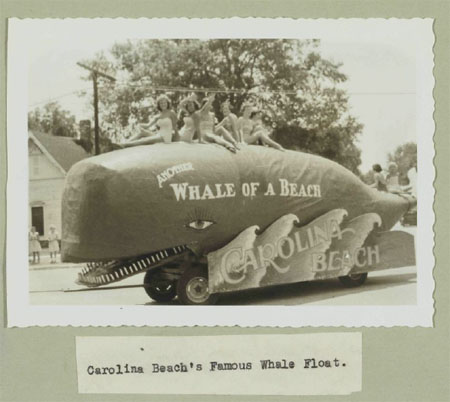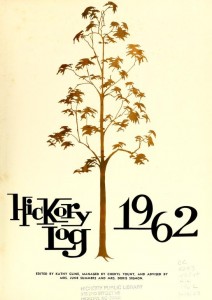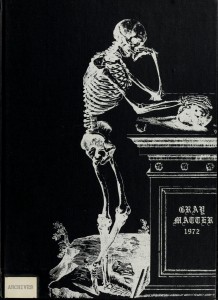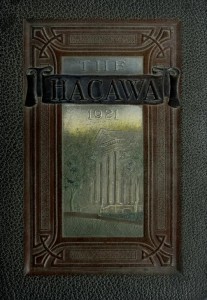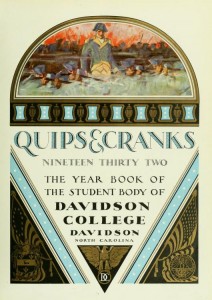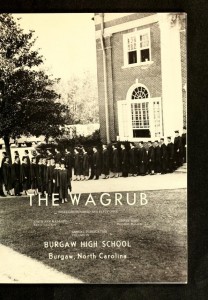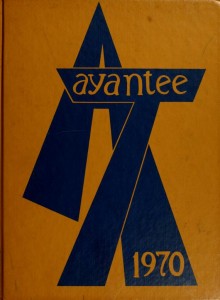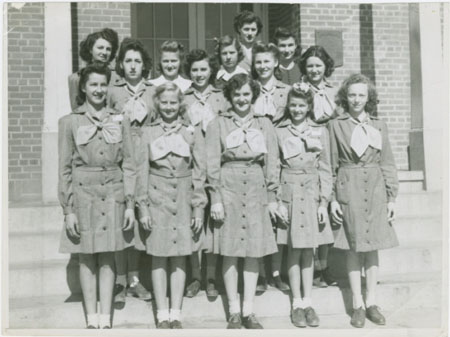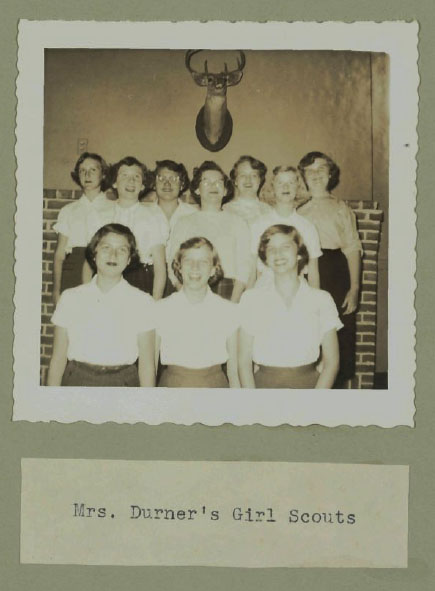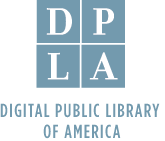 Elon University, Pender County Public Library, and UNC-Charlotte are the three newest North Carolina institutions to join the Digital Public Library of America. North Carolina institutions are now represented with almost 160,000 digital items.
Elon University, Pender County Public Library, and UNC-Charlotte are the three newest North Carolina institutions to join the Digital Public Library of America. North Carolina institutions are now represented with almost 160,000 digital items.
The North Carolina Digital Heritage Center is the DPLA’s hub in North Carolina. You can read more about the DPLA and North Carolina in an earlier blog post from the official launch last month.
We’ve just finished digitizing a dozen scrapbooks from the Pender County Public Library documenting the diverse activities of the Burgaw Jaycees, primarily in the 1950s. The scrapbooks contain photographs, newspaper clippings, and a few documents related to the work of the Jaycees.
I especially like the “For a Finer Carolina” volume, compiled in 1954 in celebration of the town’s Diamond Jubilee (the 75th anniversary of the incorporation of the town of Burgaw). The scrapbook includes photos from parades, contests, and celebrations and is an interesting look at life in southeastern North Carolina in the mid 20th-century. It also includes this great photo of “Carolina Beach’s Famous Whale Float.”
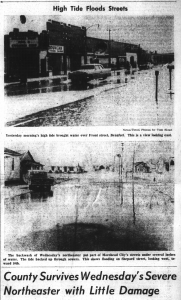 Sometimes, it’s easy to feel like the problems of today are unique to our time and place, but this latest batch of the Carteret County News-Times (1960-1963) demonstrates that people have been working through similar problems for at least 50 years. One issue, from March 16, 1962, somehow touches on big storms flooding the area (and the difficulty of insuring coastal property), U.S. House elections, and redistricting—almost as if it were printed in 2022.
Sometimes, it’s easy to feel like the problems of today are unique to our time and place, but this latest batch of the Carteret County News-Times (1960-1963) demonstrates that people have been working through similar problems for at least 50 years. One issue, from March 16, 1962, somehow touches on big storms flooding the area (and the difficulty of insuring coastal property), U.S. House elections, and redistricting—almost as if it were printed in 2022.
Luckily, no one died in the nor’easter that hit Morehead City and the rest of the coast in March 1962, but the storm did cause quite a bit of damage. A paper from the preceding week (March 2, 1962) pictures flooding along some of the commercial streets and describes buildings that were not up to code to withstand the storm. One commissioner reported that an insurance firm in New York abstained from insuring the area because of the building code problems. A week later, a headline reads (perhaps unsurprisingly): “Red Cross Says Best Way to Help Dare Is Give to Local Red Cross.”
Another front page story describes a bid for the 3rd Congressional District by Morehead City resident S.A. Chalk Jr. Chalk Jr. ran against incumbent David Henderson in the Democratic primary (though in a much different Democratic party than we think of today). He accused Henderson of voting for “policies that are bound to cause even further trouble,” saying, “He claims he’s conservative, but his voting records do not bear this out.” Chalk Jr. still lost the primary, apparently, as Henderson went on to represent the district until 1977.
Aside from the familiar arguments of House elections, the article also mentions that Harnett County was added to the district in 1960. And while the headlines haven’t changed much over the last 50 years, the list of counties included in the 3rd District certainly has. In 1962, the district included 10 counties: Carteret, Craven, Duplin, Harnett, Jones, Onslow, Pamlico, Pender, Sampson, and Wayne. In 2023, the district will expand and morph to contain parts of 15 counties: Beaufort, Camden, Carteret, Craven, Currituck, Dare, Duplin, Hyde, Jones, Lenoir, Onslow, Pamlico, Pitt (partly), Sampson, and Wayne (partly). For visual thinkers, an interactive map of NC’s congressional districts can be found here.
You can see the full batch of the Carteret County News-Times here and explore all of our digital newspapers in our North Carolina Newspapers collection. You can also explore more materials from the Carteret County Public Libraries on their partner page and their website.
A handful of student yearbooks from Burgaw High School are now available in the North Carolina High School Yearbooks collection. The yearbooks, from the years 1956 through 1962, are from the local history collection at the Pender County Public Library.
I’m embarrassed to admit that it took us a while to figure out the origin of the title of the yearbooks: “The Wagrub.” We thought first that it might be a Native American name, or maybe something from a school song or cheer, before finally realized that it is, simply, the name of the town spelled backwards.
These yearbooks complement other materials from the Pender County Public Library already available on DigitalNC, including a great
set of scrapbooks compiled by the Burgaw Jaycees in the 1950s.
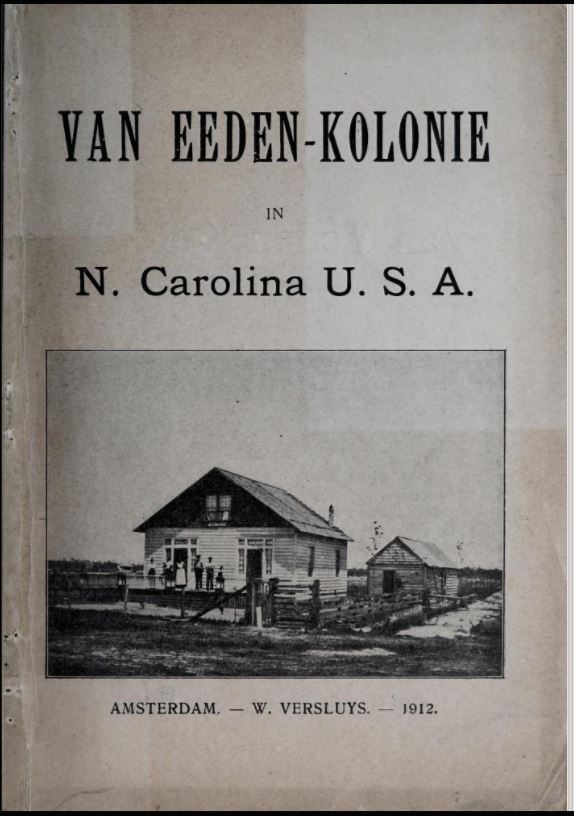
Yesterday, on April 18, a new historical marker was unveiled in Pender County honoring the farming community of Van Eeden. Van Eeden was located north of Burgaw and was owned by Hugh MacRae, who tried to start a farm colony with Dutch settlers there in the early 1900s that was named for Frederik Van Eeden, a Dutch psychiatrist and author, who helped MacRae recruit Dutch immigrants.
We digitized a pamphlet that was put out in the Netherlands to promote the colony in 1913. The pamphlet is in Dutch and English.
The colony was not very successful, but in the late 1930s, it fulfilled a new purpose. Alvin Johnson, the founder of the New School in New York, was working hard to bring as many Jewish refugees from Germany as possible, but was having difficulty working through the rules of the State Department. He found a loophole in the law though; there was no quota on those who came as farm workers. Working with MacRae, Johnson brought several Jewish families to Van Eeden to escape the Nazis. Susan Block wrote a book about the experience of those families who came from Germany and adjusting to life on a farm in eastern North Carolina titled Van Eeden, which we digitized as well.
To learn more about our partner Pender County Public Library, visit their partner page. And to learn more about Van Eeden, visit the great libguide built by Pender County Public Library.
Here are our picks for the 7 cleverest North Carolina yearbook titles in our collection.
#7 “Hickory Log” Hickory High School
A clever play on words for this “log” of the year’s activities. View all Hickory High School yearbooks, courtesy the Hickory Public Library.
#6 “The Si Si” University of North Carolina at Charlotte
The University of North Carolina at Charlotte was formerly known as Charlotte College. View all University of North Carolina at Charlotte yearbooks.
#5 “Gray Matter” Wake Forest School of Medicine
There are all kinds of clever covers for this intellectually themed, physiologically fitting title. View all Wake Forest School of Medicine yearbooks.
#4 “Hacawa” Lenoir-Rhyne University
“Hacawa” is a one-word abbreviation of Halls, Campus, Walls. In and around these centers the whole student life here. The Hacawa is an emanation from the work, play, joys, trials, and triumphs of the entire college for the year.” (1909 Hacawa, p. 8) View all Lenoir-Rhyne University yearbooks.
#3 “Quips and Cranks” Davidson College
“Haste thee nymph, and bring with thee
Jest and youthful Jollity,
Quips and cranks, and wanton wiles,
Nods, and becks, and wreathed smiles…” – L’Allegro, by John Milton
View all Davidson College yearbooks
#2 “Wagrub” Burgaw High School
We like this title because the students capitalized on the school name they were dealt. View all Burgaw High School yearbooks, courtesy the Pender County Public Library.
#1 “Ayantee” North Carolina Agricultural and Technical State University
You may need to say our the title out loud before it sinks in. This one has stumped staff in the past, making it our #1 pick. View all North Carolina Agricultural and Technical State University yearbooks.
Disagree with our picks? Let us know.
Today’s @ncnewspapers headline, from Raeford in 1953, reads “Lions Club Plans Womanless Wedding.” While womanless weddings of a different sort are in the news these days as North Carolina prepares to vote on a proposed constitutional amendment, the event mentioned in the headline was a popular form of entertainment in small towns a few decades ago.
A “womanless wedding” was usually held as a fundraiser and involved prominent men of the community dressing up in full bridal outfits for a mock wedding ceremony. From the stories I’ve heard, it was common practice to get the burliest man in town to play the part of the bride, backed up by a train of equally rough-looking bridesmaids.
I found a couple of newspaper photos of womanless weddings in the DigitalNC collection. The first is from Burgaw in 1957 and was held as a fundraiser for the local high school (from the
Burgaw Jaycees Scrapbook, 1957-1958, contributed by the Pender County Public Library). The second is from a Bennett College fundraiser in 1974 (from the
Bennett College Scrapbook, 1972-1977).
As the Girl Scouts of the USA celebrate their centennial this year, I wanted to look for historic images of Girl Scouts in North Carolina on DigitalNC. It’s clear that the Girl Scouts have been active throughout the state for many decades. Here are a few highlights from the handful of interesting photos and items relating to Girl Scouts on DigitalNC.org.
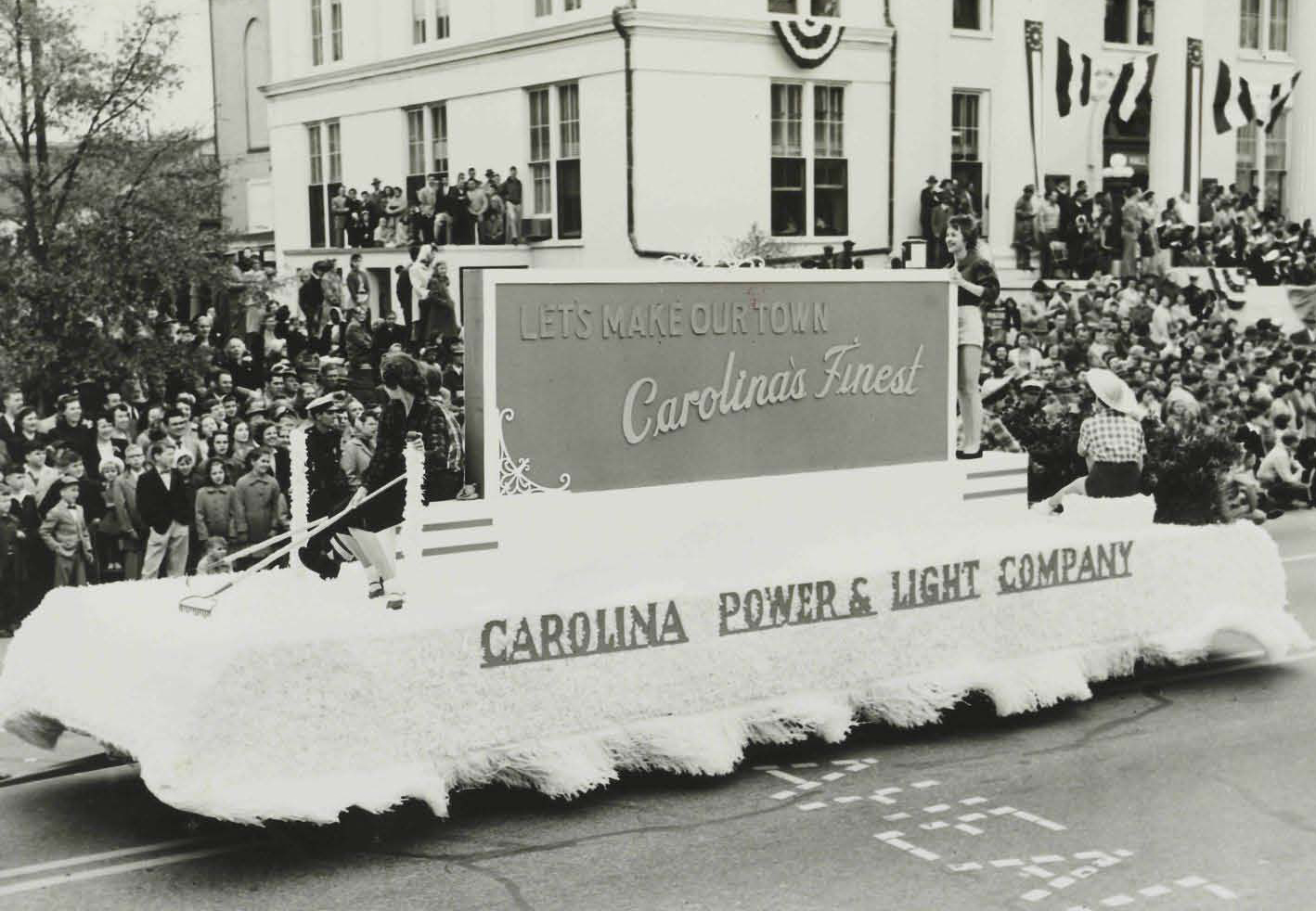
From 1952 to 1959 the Carolina Power and Light Company (CP&L) hosted a “Finer Carolina” contest, in which cities and towns in the CP&L service area vied for cash awards by engaging in community improvements. From a history of CP&L I learned that over the seven years the competition was held 4,600 projects were undertaken, including those aimed at “beautifying residential areas, improving cultural opportunities, upgrading municipal facilities, stimulating business, and attracting new industry.”
Some materials on DigitalNC are evidence of the participation of North Carolina’s communities, such as this 1954 scrapbook from the town of Burgaw documenting their Finer Carolina activities. The year 1954 was a banner year for the contest, according to a front-page article in the February 25, 1954 issue of the Raeford News-Journal. During this year there were 160 entries, including Raeford, N.C., competing for $6,750 in prizes. The Architectural History of Randolph County, N.C., also mentions the Finer Carolina contest, as the city of Asheboro took home the winning prize in 1954, as well as 1955, 1956, and 1958. But perhaps these awards weren’t such a boon for Asheboro after all, as the history describes the city’s improvement projects as resulting in “the nearly total destruction of the city’s nineteenth-century heritage”.
Items featured in this post are shared on DigitalNC by Pender County Public Library and Randolph County Public Library.

This week we have another 34 newspaper titles up on DigitalNC, including four from Carthage, North Carolina: Former home to the Tyson & Jones Buggy Company.
The “Jones” of the Tyson & Jones Buggy Company was William T. Jones, who was born into slavery and became one of the most well-respected and wealthiest businessmen in Carthage. Born near Elizabethtown in 1833, his father was a plantation owner and his mother was an enslaved person. Prior to the Civil War, he was given his freedom and moved to Fayetteville to work as a painter for a carriage company. It was there that his work was noticed by Thomas Tyson, who convinced him to come to Carthage to work for his fledgling operation in 1857, and by 1859 Jones was made a partner in that company. In 1861, Jones joined the Confederate Army and was subsequently captured by Union forces. While imprisoned at Fort Delaware, Jones began making moonshine from potato peelings and bread crusts and selling it to the Union guards. After Sherman’s March left much of the area devastated, it was the Jones’ moonshine money that allowed the Tyson & Jones Buggy Company to restart production, employing many struggling locals and helping to restart the local economy.
Even though Jones was a captain of industry, North Carolina House of Representatives candidate, and Sunday School teacher with a legacy that lives on in Carthage, it was not widely acknowledged that he wasn’t White. It wasn’t until recently that him being a Black man was recognized as fact and his full story was told.
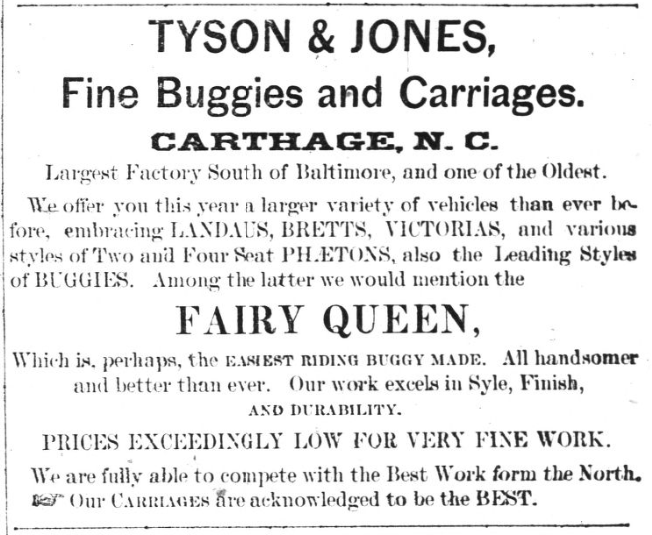
Over the next year, we’ll be adding millions of newspaper images to DigitalNC. These images were originally digitized a number of years ago in a partnership with Newspapers.com. That project focused on scanning microfilmed papers published before 1923 held by the North Carolina Collection in Wilson Special Collections Library. While you can currently search all of those pre-1923 issues on Newspapers.com, over the next year we will also make them available in our newspaper database as well. This will allow you to search that content alongside the 2 million pages already on our site – all completely open access and free to use.
This week’s additions include:
- The Central Times (Dunn, N.C.) – 1892-1894
- The Albemarle Chronicle (Albemarle, N.C.) – 1912
- The Chronicle (Albemarle, N.C.) – 1912-1915
- Daily Concord Standard (Concord, N.C.) – 1898-1899
- The Chatham Record (Pittsboro, N.C.) – 1899
- Moore Gazette (Carthage, N.C.) – 1881-1885
- The Carthaginian (Carthage, N.C.) – 1878
- Moore Index (Carthage, N.C.) – 1879-1880
- The Southern Protectionist (Carthage, N.C.) – 1888
- The Sampson Democrat (Clinton, N.C.) – 1920-1921
- The High Point Enterprise (High Point, N.C.) – 1893-1915
- Daily Enterprise (High Point, N.C.) – 1906-1908
- The Patriot and Times (Greensboro, N.C.) – 1869
- The Greensboro Patriot (Greensboro, N.C.) – 1869-1918
- Greensboro Patriot (Greensboro, N.C.) – 1880
- The Daily Evening Patriot (Greensboro, N.C.) – 1890
- The Watchman and Harbinger (Greensboro, N.C.) – 1863-1864
- The New North State (Greensboro, N.C.) – 1878
- The North State (Greensboro, N.C.) – 1878-1885
- The Beacon (Greensboro, N.C.) – 1880
- The Rowan Record (China Grove, N.C.) – 1909-1919
- China Grove Record (Salisbury, N.C.) – 1920-1925
- Jackson County Journal (Sylva, N.C.) – 1913-1919
- The Ansonian (Wadesboro, N.C.) – 1907-1908
- The Pender Chronicle (Burgaw, N.C.) – 1912-1943
- Harnett County News (Lillington, N.C.) – 1919-1922
- Goldsboro’ News (Goldsboro, N.C.) – 1867-1873
- Goldsboro Daily Messenger (Goldsboro, N.C.) – 1869
- Goldsboro Daily Argus (Goldsboro, N.C.) – 1911
- The Evening Review (Wilmington, N.C.) – 1875-1877
- The Morning Star (Wilmington, N.C.) – 1881
- The Tribune (Henderson, N.C.) – 1873-1876
- The Henderson Pioneer (Hendersonville, N.C.) – 1866-1867
- The Daily Herald (Hendersonville, N.C.) – 1911-1912
If you want to see all of the newspapers we have available on DigitalNC, you can find them here. Thanks to UNC-Chapel Hill Libraries for permission to and support for adding all of this content as well as the content to come. We also thank the North Caroliniana Society for providing funding to support staff working on this project.
 Elon University, Pender County Public Library, and UNC-Charlotte are the three newest North Carolina institutions to join the Digital Public Library of America. North Carolina institutions are now represented with almost 160,000 digital items.
Elon University, Pender County Public Library, and UNC-Charlotte are the three newest North Carolina institutions to join the Digital Public Library of America. North Carolina institutions are now represented with almost 160,000 digital items.